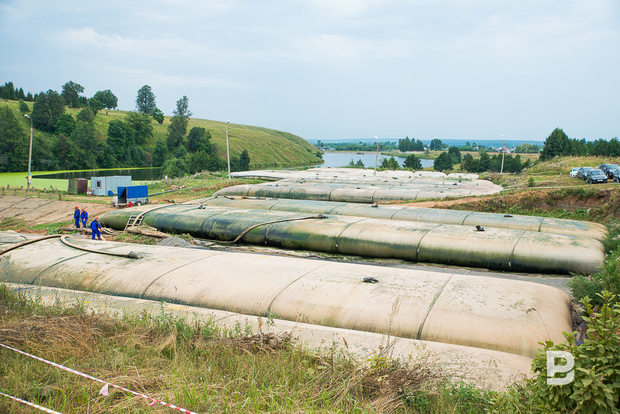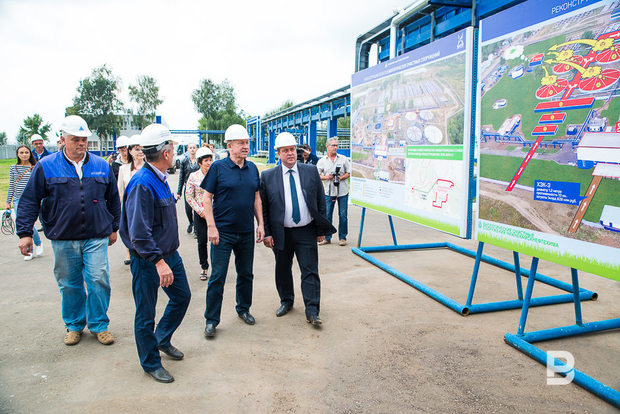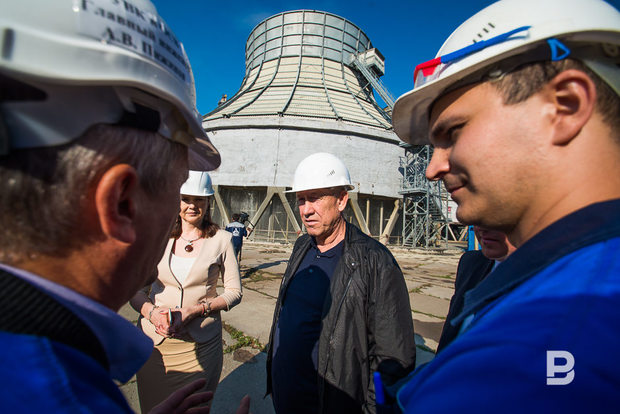Caring about environment: Nizhnekamskneftekhim implements the environmental programme
In the Year of Environment, the city-forming enterprise has signed the quadripartite agreement with the Ministry of Natural Resources of Russia, Rosprirodnadzor and the government of the Republic of Tatarstan. Thus, the company voluntarily has undertaken to report on how it cares about nature. A delegation from the management of Rosprirodnadzor of the Republic of Tatarstan came to check what promises have already been implemented. When the second phase of biological treatment facilities realization will start and how the company plans to reduce the consumption of fresh river water — read in the material of Realnoe Vremya.
Treatment of the buffer ponds on the Tunguch river
The buffer ponds on the Tunguch river. It receives effluents from the industrial zone of Nizhnekamsk — the so-called conditionally clean drains. Here they are treated in a natural way: in the first pond there settles on the bottom the water-insoluble dirt, water through the fence flows into the second pond and then discharged into the river Tunguch. Such system of natural purification steadily worked since 1973, but several years ago it became clear that the ponds already do not cope with the task. Over the years, much sludge accumulated on the bottom so that it is only about two meters to the surface, for comparison, the natural water depth is about nine metres. Then it was taken the decision to clean the pond. The employees of Rosprirodnadzor are shown how the floating excavator Amphibian pumps out from the bottom the silt and pumps it into geotubes — huge ''bags''. Inside it is added a reagent in order the excess moisture is gone in a few months and the contents of ''bags'' became hard. Then, the geotubes are cut, and sludge is sent to the sludge tank. In this way, the pond is being cleaned for the third summer.

''Now the water that is purified here is discharged into the river, but the leadership set the task to return this water in the process — due to this, we will save water from Kama river. A few years ago, the studies of the pond were conducted, and scientific and technological center concluded that the remaining free surface of the water cannot provide such treatment that the water could be returned in the process. So they decided to increase the depth of the pond in order the physical treatment was more effective. Further we plan to deliver an additional treatment plant using ultrafiltration and to return water to the process through pipes for production needs,'' says deputy chief engineer of Nizhnekamskneftekhim for environment protection Andrey Rubezhov.
''The main goal is reducing the negative impact on the city''
If conditionally clean wastewater go to the buffer ponds, then dirty ones are sent to biological treatment facilities (BTF). It is a huge complex that receives household sewage from Nizhnekamsk as well as chemically contaminated runoff from the industrial hub. The BTF were built in 1966, in 1980 the facility was reconstructed to increase capacity. But over 50 years of the operation, the equipment of biological treatment plants has become out of date, so a few years ago they started to think about reconstruction.
''If the project of the first treatment suggested that treated effluents should contain 2 milligrams of petroleum products per liter, now the ratio is 0,05. That is, with the old technology it is impossible to achieve a stable quality treatment. Therefore, the leadership decided to modernize,'' explains the chief engineer of the department of water supply, sewerage and wastewater treatment of Nizhnekamskneftekhim Alexander Pizhinov.
At the first stage they reconstructed mechanical hub of domestic wastewaters. As a result, the quality of treated effluents in the first half of 2017, compared to the same period in 2016, has improved by 14 indicators. For example, the concentration of nitrates decreased by 32%, the index of water pollution decreased by 5 points. The reconstruction of the first phase cost about 600 million rubles, and since January they plan to start the second phase of modernization of the BTF, during which it will be reconstructed the hub, which receives runoff from the Nizhnekamsk industrial hub.
''The main goal is reducing the negative impact on the city. We have all the requirements on emissions at appropriate level, but some products have so unpleasant smell that they even in small concentrations cause discontent of citizens. So we decided to install preaerators where all hydrocarbons from effluents will be neutralized, that is, the emissions will be eliminated,'' says Alexander Pizhinov.

The second stage of the modernization will start in January, and the company plans to complete it by 2020. The reconstruction of the BTF is under control of the government. In the year of environment, which continues in the country, 55 Russian enterprises have signed a quadripartite agreement with the Ministry of Natural Resources, Rosprirodnadzor and regional governments. In Tatarstan, the agreement was signed by five companies, out of which three companies are included in the group TAIF — Nizhnekamskneftekhim, TAIF-NK and Kazanorgsintez.
''The very first of them who concluded the agreement was Nizhnekamskneftekhim to show its openness and what is being done to improve the ecological status. Indeed, large funds are invested. On the Tunguch river, the discharge of treated effluent has decreased after installing more treatment plants, with the beginning of return of the treated water in the process. On the one hand, it is a plus for nature, on the other — profitable for the enterprise. There also was a progress concerning the BTF. Next year, the enterprise comes to the final stage, in which it is planned to invest about 800 million rubles. This will help to eliminate odors and reduce the amount of pollutants during the discharge into the Kama River. Yes, it doesn't bring profit for the enterprise, but it's a social issue. If they continue to work in this direction, it will be appreciated by the residents,'' said the head of Rosprirodnadzor management in Tatarstan Farit Khayrutdinov.
Emission reduction and production output increase
Nizhnekamskneftekhim has always paid attention to environmental issues. Since 2001, the company has implemented the fourth environmental programme for 2014-2020, for which for three years it has been allocated 2,7 billion rubles. Environmental measures yield results: since 2001, the output of commercial products increased twice, while the emissions of harmful substances was reduced by 54%.
''In 2016, compared to 2013, the consumption of fresh river water decreased by 3,558,200 cubic meters, or 5%. The number of not disposed waste of the production was decreased by 624 tonnes, the discharge of wastewater after the buffer ponds has been reduced by 66%,'' sums up the chief engineer of the department of water supply, sewerage and wastewater treatment of Nizhnekamskneftekhim.

Nizhnekamskneftekhim consumes about 68 million cubic meters of fresh river water annually, so the priority is the question of the use of water resources efficiency increase. For this, the cooling towers, a kind of ''refrigerators'', which cool the heated water, are reconstructed annually.
''If you observe the work of the cooling tower, it is unclear how it is related to saving of resources. But Nizhnekamskneftekhim at first industrial site alone has 30 similar cooling towers. And if at one of them we can save at least half a percent of the water, then multiplying it by 30, we will see that there are millions of cubic meters of water of the Kama water, which, thanks to the maintenance of cooling towers, we do not need to withdraw from nature,'' Alexander Pizhinov.
In 2017, they completed the construction of three towers, and now another three are being under overhaul. Seventy percent of the costs for environmental measures that Nizhnekamskneftekhim declared this year, signing the quadripartite agreement, have been implemented. The rest will be implemented before the end of the year in full, promised the employees of the enterprise to the head of Rosprirodnadzor.